外研版(2019)选择性必修 第三册Unit1Face values Developing ideas 课件(共33张PPT)
文档属性
| 名称 | 外研版(2019)选择性必修 第三册Unit1Face values Developing ideas 课件(共33张PPT) |
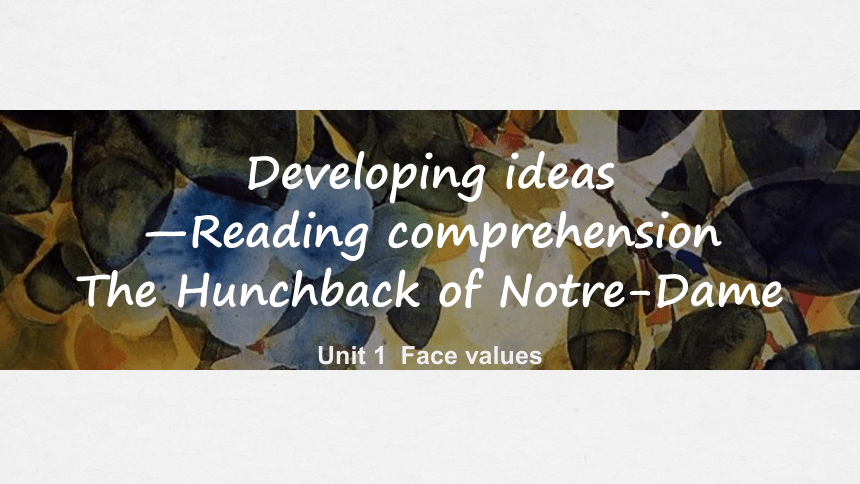
|
|
| 格式 | pptx | ||
| 文件大小 | 25.7MB | ||
| 资源类型 | 教案 | ||
| 版本资源 | 外研版(2019) | ||
| 科目 | 英语 | ||
| 更新时间 | 2024-04-04 20:18:25 | ||
图片预览

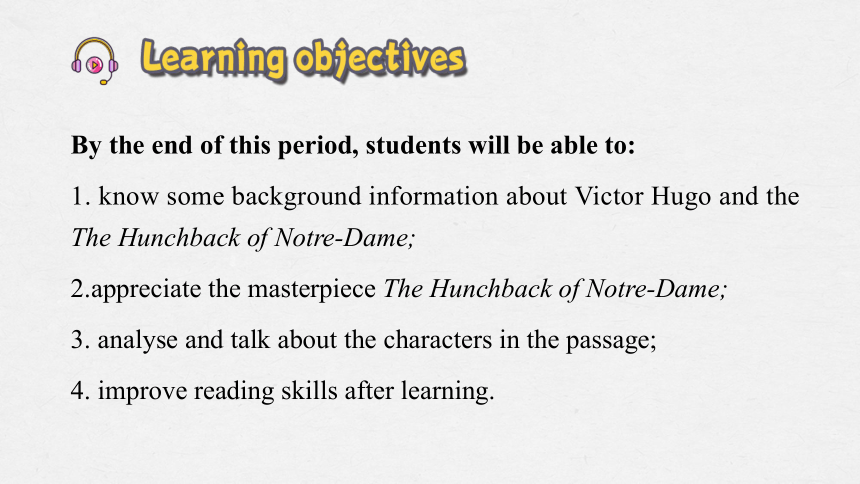
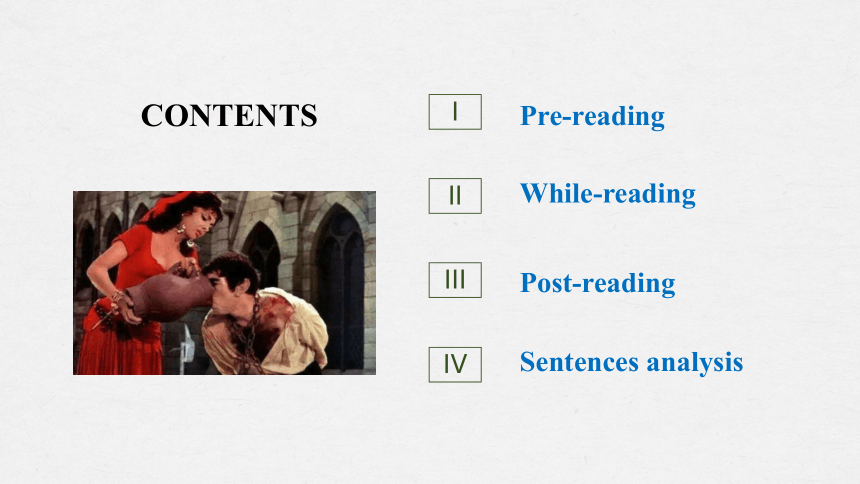
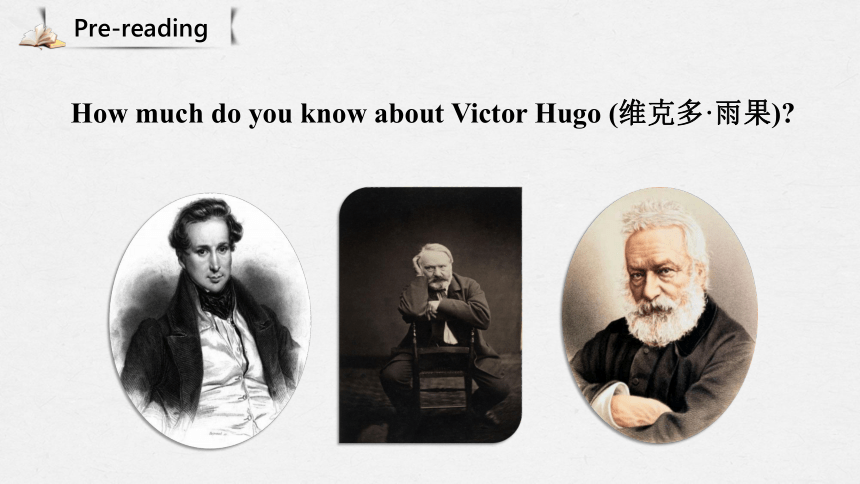
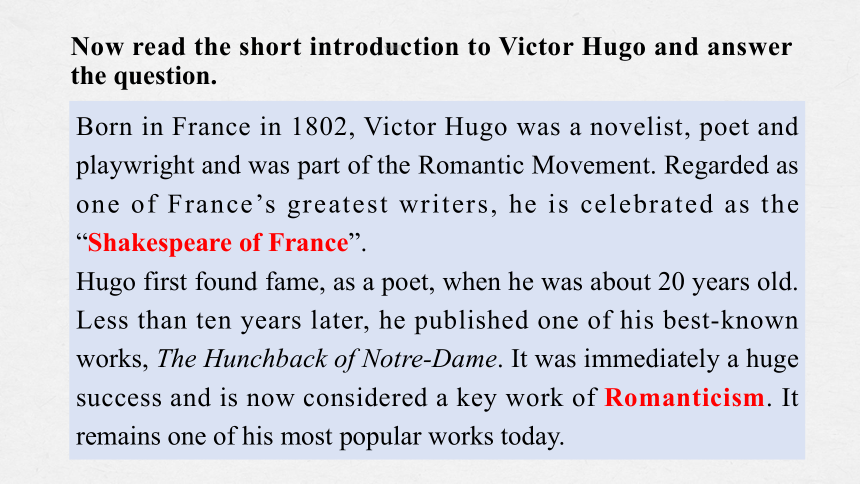
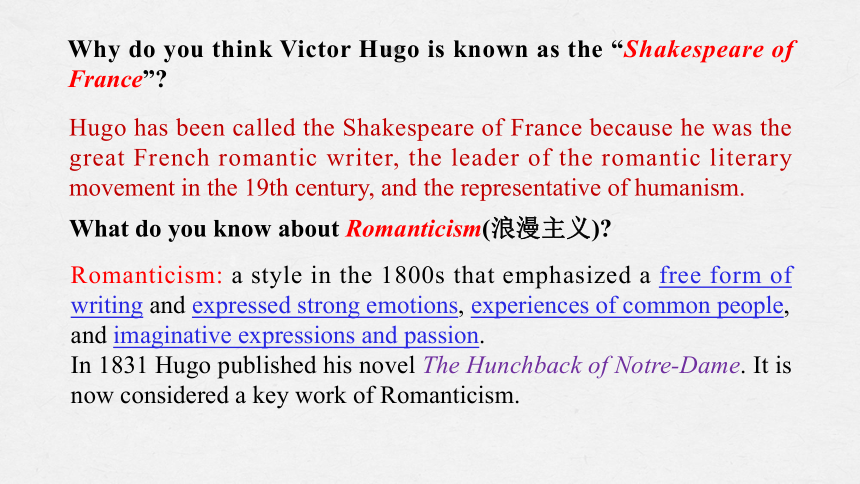
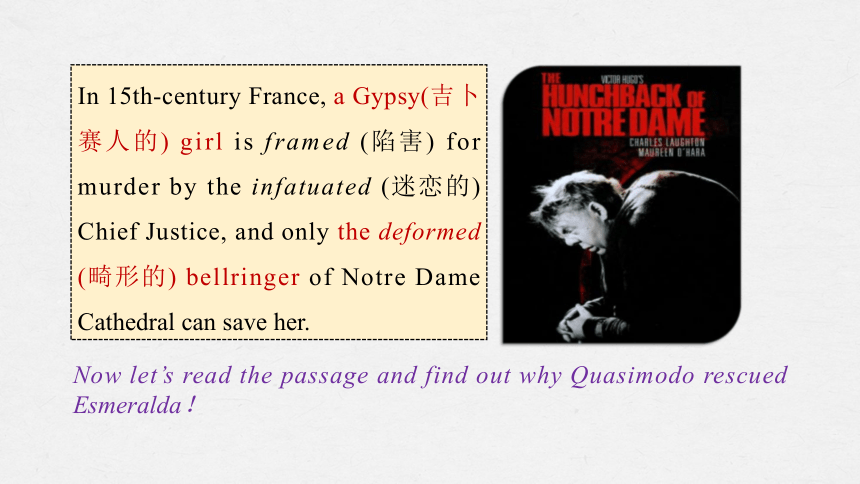
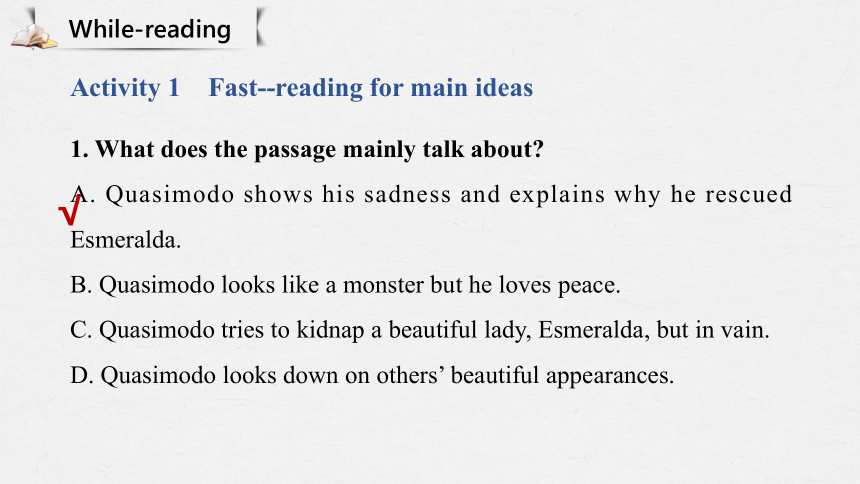
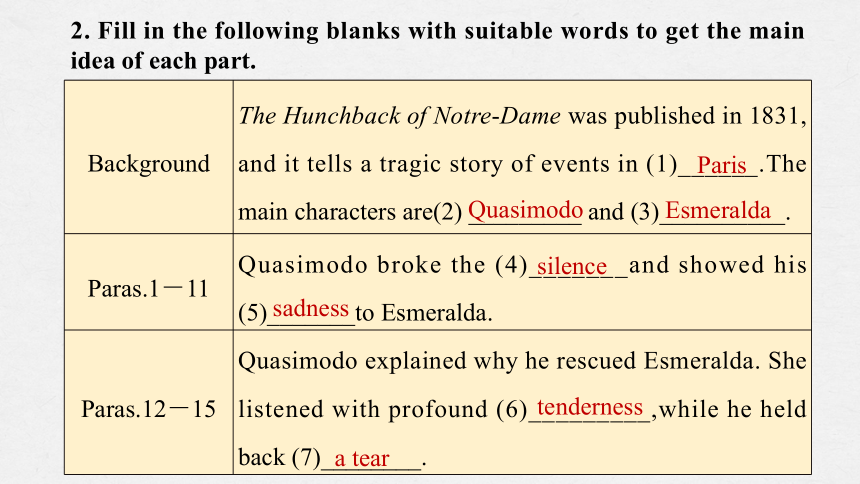
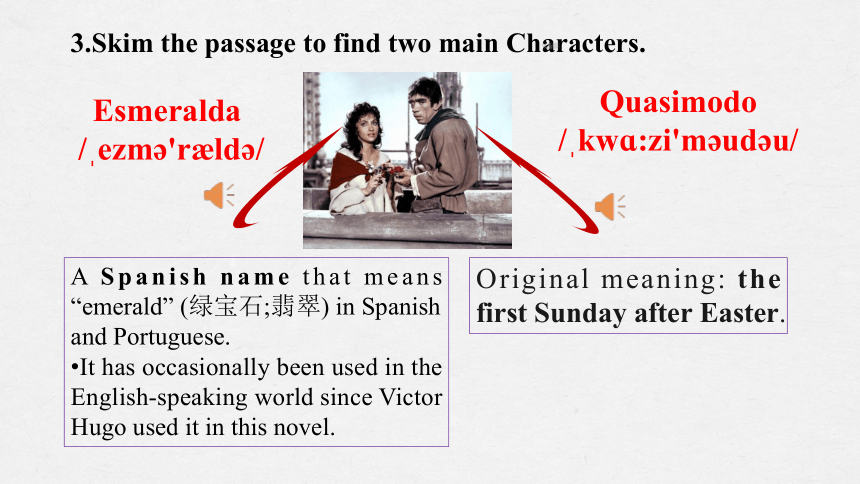
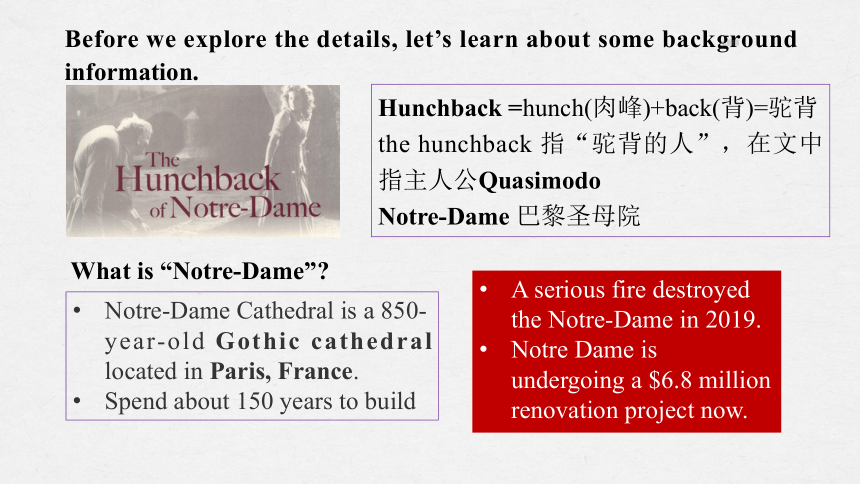
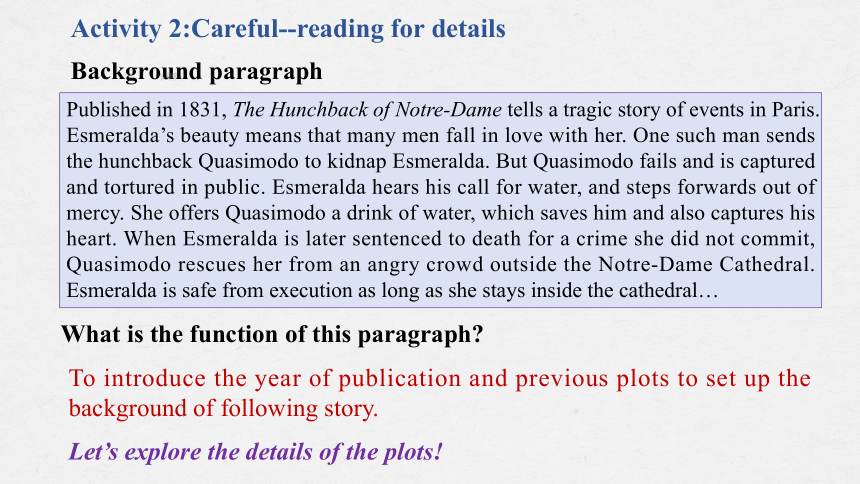
文档简介
(共33张PPT)
Developing ideas
—Reading comprehension
The Hunchback of Notre-Dame
Unit 1 Face values
By the end of this period, students will be able to:
1. know some background information about Victor Hugo and the The Hunchback of Notre-Dame;
2.appreciate the masterpiece The Hunchback of Notre-Dame;
3. analyse and talk about the characters in the passage;
4. improve reading skills after learning.
CONTENTS
Pre-reading
I
While-reading
II
Post-reading
III
Sentences analysis
IV
Pre-reading
How much do you know about Victor Hugo (维克多·雨果)
Born in France in 1802, Victor Hugo was a novelist, poet and playwright and was part of the Romantic Movement. Regarded as one of France’s greatest writers, he is celebrated as the “Shakespeare of France”.
Hugo first found fame, as a poet, when he was about 20 years old. Less than ten years later, he published one of his best-known works, The Hunchback of Notre-Dame. It was immediately a huge success and is now considered a key work of Romanticism. It remains one of his most popular works today.
Now read the short introduction to Victor Hugo and answer the question.
Why do you think Victor Hugo is known as the “Shakespeare of France”
Hugo has been called the Shakespeare of France because he was the great French romantic writer, the leader of the romantic literary movement in the 19th century, and the representative of humanism.
What do you know about Romanticism(浪漫主义)
Romanticism: a style in the 1800s that emphasized a free form of writing and expressed strong emotions, experiences of common people, and imaginative expressions and passion.
In 1831 Hugo published his novel The Hunchback of Notre-Dame. It is now considered a key work of Romanticism.
In 15th-century France, a Gypsy(吉卜赛人的) girl is framed (陷害) for murder by the infatuated (迷恋的) Chief Justice, and only the deformed (畸形的) bellringer of Notre Dame Cathedral can save her.
Now let’s read the passage and find out why Quasimodo rescued Esmeralda!
While-reading
Activity 1 Fast- reading for main ideas
1. What does the passage mainly talk about
A. Quasimodo shows his sadness and explains why he rescued Esmeralda.
B. Quasimodo looks like a monster but he loves peace.
C. Quasimodo tries to kidnap a beautiful lady, Esmeralda, but in vain.
D. Quasimodo looks down on others’ beautiful appearances.
√
2. Fill in the following blanks with suitable words to get the main idea of each part.
Background The Hunchback of Notre-Dame was published in 1831, and it tells a tragic story of events in (1)______.The main characters are(2) _________ and (3)__________.
Paras.1-11 Quasimodo broke the (4)_______and showed his (5)_______to Esmeralda.
Paras.12-15 Quasimodo explained why he rescued Esmeralda. She listened with profound (6)_________,while he held back (7)________.
Paris
Quasimodo
silence
sadness
tenderness
a tear
Esmeralda
3.Skim the passage to find two main Characters.
Esmeralda
/ ezm 'r ld /
Quasimodo / kwɑ:zi'm ud u/
Original meaning: the first Sunday after Easter.
A Spanish name that means “emerald” (绿宝石;翡翠) in Spanish and Portuguese.
It has occasionally been used in the English-speaking world since Victor Hugo used it in this novel.
Notre-Dame Cathedral is a 850- year-old Gothic cathedral located in Paris, France.
Spend about 150 years to build
Before we explore the details, let’s learn about some background information.
Hunchback =hunch(肉峰)+back(背)=驼背
the hunchback 指“驼背的人”,在文中指主人公Quasimodo
Notre-Dame 巴黎圣母院
What is “Notre-Dame”
A serious fire destroyed the Notre-Dame in 2019.
Notre Dame is undergoing a $6.8 million renovation project now.
Published in 1831, The Hunchback of Notre-Dame tells a tragic story of events in Paris. Esmeralda’s beauty means that many men fall in love with her. One such man sends the hunchback Quasimodo to kidnap Esmeralda. But Quasimodo fails and is captured and tortured in public. Esmeralda hears his call for water, and steps forwards out of mercy. She offers Quasimodo a drink of water, which saves him and also captures his heart. When Esmeralda is later sentenced to death for a crime she did not commit, Quasimodo rescues her from an angry crowd outside the Notre-Dame Cathedral. Esmeralda is safe from execution as long as she stays inside the cathedral…
What is the function of this paragraph
To introduce the year of publication and previous plots to set up the background of following story.
Background paragraph
Let’s explore the details of the plots!
Activity 2:Careful- reading for details
Plots
1.Underline the sentences that describe Esmeralda and Quasimodo’s appearances and feelings.
Esmeralda in Quasimodo’s eyes
________________
________________
________________
________________
Quasimodo in Esmeralda’s eyes
__________________
__________________
__________________
__________________
Read Paras.1-11 carefully and do the following exercises.
Quasimodo in Esmeralda’s eyes:
Esmeralda thought Quasimodo was repulsive with knock knees, a hunched back and a single eye; yet beneath his ugliness, he was full of melancholy and gentleness.
knock knees hunched back
膝外翻 驼背
Quasimodo’s appearance
Quasimodo’s inside
First, she thought he was_________;
Then she felt_____________ towards him.
horrible
sympathetic
1. What can we know from the first paragraph
A. Quasimodo was a normal person.
B. Quasimodo was disabled.
C. Esmeralda was disappointed to see Quasimodo’s appearance.
D. Quasimodo was kind and gentle.
√
Esmeralda in Quasimodo’ s eye:
Quasimodo thought Esmeralda was graceful and exquisitely beautiful, like a ray of sunshine, a drop of dew or a birdsong.
Quasimodo’s feeling
......poor unfortunate monster that I am......
You, you are a ray of sunshine, a drop of dew, a birdsong......
What figure of speech was used in the above sentences when Quasimodo described Esmeralda and himself
Personification. B. Simile.
C. Hyperbole. D. Irony
√
1.Why did Quasimodo save Esmeralda
A. To kidnap her.
B. To repay her kindness.
C. To enjoy her beauty.
D. To make her moved.
2.Underline the sentence in the passage.
√
Read Paras. 12-15 carefully and do the following exercises.
She listened to him with profound tenderness. A tear swam in the eye of Quasimodo, but did not fall. He seemed to make it a point of honour to keep it at bay. (para15)
keep/hold…at bay 阻止……发生;使……不能接近
4.We can infer the personality from the underlined sentence that:
On one hand, it shows that Quasimodo is ________and ________; on the other hand, it shows his _________ and ________.
3.What does the underlined sentence in Para.15 tells us
A. Quasimodo was a man with a strong heart.
B. Quasimodo was a man who won sympathy by tears.
C. Quasimodo didn’t want to be seen as weak inside.
D. Quasimodo was an emotional person.
√
sensitive gentle
strength pride
1.What kind of story does The Hunchback of Notre-Dame belong to
A.Tragedy. B.Comedy.
C.Historical drama. D.Modern drama.
2.From the introduction of the novel, what kind of person do you think Esmeralda is
A.Cruel. B.Evil. C.Kind. D.Ugly.
√
√
Read the whole passage again and do the following exercises.
3.How did Quasimodo describe himself in the ninth paragraph
A.By giving examples. B.By providing data.
C.By making comparison. D.By telling a story.
4.What can we learn about Quasimodo from the text
A.Although ugly, he is kind to some degree.
B.He is ugly and eager to get sympathy from others.
C.He is not only ugly but cruel to others.
D.He is neither human nor beast.
√
√
Post-reading
Students’ own answers.
1. If you met a man like Quasimodo in the real world, would you be friends with him (Critical thinking)
Activity 1 Discussion
2. Predict what happens next, and share your idea with your classmates.(Creative thinking)
The Hunchback of Notre-Dame, the writer of 1.______ is Victor Hugo, a novelist, poet and playwright, tells a 2.________(tragedy) story of events in Paris. Esmeralda was a beautiful girl while Quasimodo was an ugly man. Quasimodo failed when he tried to kidnap Esmeralda and was captured and tortured in public. Esmeralda offered Quasimodo a drink of water out 3.___mercy, which saved him and also captured his heart. When Esmeralda 4.____________(sentence) to death for a crime she did not commit, Quasimodo rescued her.
which
tragic
of
was sentenced
Activity 2 Summary
They were still for several moments. 5. ___________(eventual) Quasimodo was the first 6.___________(break) the silence. He said that he was something terrible, 7.________ human nor beast, whilst she was a ray of sunshine, a drop of dew, a birdsong. But she wanted to obtain his explanation of why he rescued her. He replied that he was repaying for the water and pity she showed to him. She listened to him with profound 8._________(tender). A tear 9._______(swim) in his eye, but didn’t fall. He seemed to make 10.__ a point of honour to keep it at bay.
neither
tenderness
swam
to break
it
Eventually
Sentences Analysis:
1. She offers Quasimodo a drink of water, which saves him and also captures his heart.
[句式分析] 此句为__________句;主句为:____,主句中offer用法为___________,which引导_________________,关系代词which 在从句中作________,代指前面所说的事情。
[自主翻译]
主从复合
非限制性定语从句
主语
她给卡西莫多递上水,这不仅拯救了他的生命,也俘获了他的心。
offer sb sth
2. When Esmeralda is later sentenced to death for a crime she did not commit, Quasimodo rescues her from an angry crowd outside the Notre-Dame Cathedral.
[句式分析] 该句是__________句;主句为:___ ;when 引导_____________从句,其中she did not commit 是省略了关系代词that/which 的________从句,修饰a crime,be sentenced to death意为“______________”。
[自主翻译]
主从复合
时间状语
被判死刑
后来当埃斯梅拉达因莫须有的罪名被判死刑时,卡西莫多从圣母院外喧哗的人群中救下了她。
定语
3. Esmeralda and Quasimodo were still for several moments, as they considered their predicament in silence, she so graceful, he so repulsive.
[句式分析] 此句为_________句,主句为:_____;as引导_________从句;she so graceful,he so repulsive为___________结构,作________。此结构由名词或代词和非谓语动词、形容词、副词或介词短语等两部分组成。
[自主翻译]
主从复合
原因状语
独立主格
状语
埃斯梅拉达和卡西莫多许久没有动,默默地思考着自己的处境,一个是那样优美,一个是那么难看。
4. How anyone could be formed in such a way was beyond her comprehension.
[句式分析] 此句为___________句,为_________结构的句子;How anyone could be formed in such a way为______从句。
[自主翻译]
主从复合
主系表
主语
她难以理解一个人怎么能长得如此畸形。
5. Yet there was so much melancholy and so much gentleness spread over all this that she gradually adjusted to it.
[句式分析] 该句是复合句,主句是___________句型,spread over all this是过去分词短语作___________。so...that...意为“____________________”,引导___________从句, adjusted to意为 “____________”。
[自主翻译]
如此……以至于……
there be
定语
结果状语
但他表现出那样的忧郁与那样的温顺,她渐渐地适应了。
调整,适应
6. I don’t know what I am, as I am coarser, more downtrodden, and plainer than a pebble!
[句式分析] 此句为__________句;主句为_______结构,what I am引导为_______从句,as引导__________从句。
[自主翻译]
主从复合
宾语
主谓宾
原因状语
我不知道我是什么,我比卵石还要粗硬、难看、不显眼!
7. You have forgotten an unfortunate person who attempted to kidnap you one night, this same person to whom you showed kindness when he was being punished.
[句式分析] 该句是__________句,主句为:____;who 引导_____从句,修饰an unfortunate person,this same person 是an unfortunate person 的__________,to whom引导________从句,其中when引导__________从句。
[自主翻译]
主从复合
定语
同位语
你忘了,有天晚上,有个坏家伙想绑架你,你却在他被惩罚时对他表示友善。
定语
时间状语
Write an article to introduce the most impressive character in The Hunchback of Notre-Dame and explain the reasons.
Homework
Developing ideas
—Reading comprehension
The Hunchback of Notre-Dame
Unit 1 Face values
By the end of this period, students will be able to:
1. know some background information about Victor Hugo and the The Hunchback of Notre-Dame;
2.appreciate the masterpiece The Hunchback of Notre-Dame;
3. analyse and talk about the characters in the passage;
4. improve reading skills after learning.
CONTENTS
Pre-reading
I
While-reading
II
Post-reading
III
Sentences analysis
IV
Pre-reading
How much do you know about Victor Hugo (维克多·雨果)
Born in France in 1802, Victor Hugo was a novelist, poet and playwright and was part of the Romantic Movement. Regarded as one of France’s greatest writers, he is celebrated as the “Shakespeare of France”.
Hugo first found fame, as a poet, when he was about 20 years old. Less than ten years later, he published one of his best-known works, The Hunchback of Notre-Dame. It was immediately a huge success and is now considered a key work of Romanticism. It remains one of his most popular works today.
Now read the short introduction to Victor Hugo and answer the question.
Why do you think Victor Hugo is known as the “Shakespeare of France”
Hugo has been called the Shakespeare of France because he was the great French romantic writer, the leader of the romantic literary movement in the 19th century, and the representative of humanism.
What do you know about Romanticism(浪漫主义)
Romanticism: a style in the 1800s that emphasized a free form of writing and expressed strong emotions, experiences of common people, and imaginative expressions and passion.
In 1831 Hugo published his novel The Hunchback of Notre-Dame. It is now considered a key work of Romanticism.
In 15th-century France, a Gypsy(吉卜赛人的) girl is framed (陷害) for murder by the infatuated (迷恋的) Chief Justice, and only the deformed (畸形的) bellringer of Notre Dame Cathedral can save her.
Now let’s read the passage and find out why Quasimodo rescued Esmeralda!
While-reading
Activity 1 Fast- reading for main ideas
1. What does the passage mainly talk about
A. Quasimodo shows his sadness and explains why he rescued Esmeralda.
B. Quasimodo looks like a monster but he loves peace.
C. Quasimodo tries to kidnap a beautiful lady, Esmeralda, but in vain.
D. Quasimodo looks down on others’ beautiful appearances.
√
2. Fill in the following blanks with suitable words to get the main idea of each part.
Background The Hunchback of Notre-Dame was published in 1831, and it tells a tragic story of events in (1)______.The main characters are(2) _________ and (3)__________.
Paras.1-11 Quasimodo broke the (4)_______and showed his (5)_______to Esmeralda.
Paras.12-15 Quasimodo explained why he rescued Esmeralda. She listened with profound (6)_________,while he held back (7)________.
Paris
Quasimodo
silence
sadness
tenderness
a tear
Esmeralda
3.Skim the passage to find two main Characters.
Esmeralda
/ ezm 'r ld /
Quasimodo / kwɑ:zi'm ud u/
Original meaning: the first Sunday after Easter.
A Spanish name that means “emerald” (绿宝石;翡翠) in Spanish and Portuguese.
It has occasionally been used in the English-speaking world since Victor Hugo used it in this novel.
Notre-Dame Cathedral is a 850- year-old Gothic cathedral located in Paris, France.
Spend about 150 years to build
Before we explore the details, let’s learn about some background information.
Hunchback =hunch(肉峰)+back(背)=驼背
the hunchback 指“驼背的人”,在文中指主人公Quasimodo
Notre-Dame 巴黎圣母院
What is “Notre-Dame”
A serious fire destroyed the Notre-Dame in 2019.
Notre Dame is undergoing a $6.8 million renovation project now.
Published in 1831, The Hunchback of Notre-Dame tells a tragic story of events in Paris. Esmeralda’s beauty means that many men fall in love with her. One such man sends the hunchback Quasimodo to kidnap Esmeralda. But Quasimodo fails and is captured and tortured in public. Esmeralda hears his call for water, and steps forwards out of mercy. She offers Quasimodo a drink of water, which saves him and also captures his heart. When Esmeralda is later sentenced to death for a crime she did not commit, Quasimodo rescues her from an angry crowd outside the Notre-Dame Cathedral. Esmeralda is safe from execution as long as she stays inside the cathedral…
What is the function of this paragraph
To introduce the year of publication and previous plots to set up the background of following story.
Background paragraph
Let’s explore the details of the plots!
Activity 2:Careful- reading for details
Plots
1.Underline the sentences that describe Esmeralda and Quasimodo’s appearances and feelings.
Esmeralda in Quasimodo’s eyes
________________
________________
________________
________________
Quasimodo in Esmeralda’s eyes
__________________
__________________
__________________
__________________
Read Paras.1-11 carefully and do the following exercises.
Quasimodo in Esmeralda’s eyes:
Esmeralda thought Quasimodo was repulsive with knock knees, a hunched back and a single eye; yet beneath his ugliness, he was full of melancholy and gentleness.
knock knees hunched back
膝外翻 驼背
Quasimodo’s appearance
Quasimodo’s inside
First, she thought he was_________;
Then she felt_____________ towards him.
horrible
sympathetic
1. What can we know from the first paragraph
A. Quasimodo was a normal person.
B. Quasimodo was disabled.
C. Esmeralda was disappointed to see Quasimodo’s appearance.
D. Quasimodo was kind and gentle.
√
Esmeralda in Quasimodo’ s eye:
Quasimodo thought Esmeralda was graceful and exquisitely beautiful, like a ray of sunshine, a drop of dew or a birdsong.
Quasimodo’s feeling
......poor unfortunate monster that I am......
You, you are a ray of sunshine, a drop of dew, a birdsong......
What figure of speech was used in the above sentences when Quasimodo described Esmeralda and himself
Personification. B. Simile.
C. Hyperbole. D. Irony
√
1.Why did Quasimodo save Esmeralda
A. To kidnap her.
B. To repay her kindness.
C. To enjoy her beauty.
D. To make her moved.
2.Underline the sentence in the passage.
√
Read Paras. 12-15 carefully and do the following exercises.
She listened to him with profound tenderness. A tear swam in the eye of Quasimodo, but did not fall. He seemed to make it a point of honour to keep it at bay. (para15)
keep/hold…at bay 阻止……发生;使……不能接近
4.We can infer the personality from the underlined sentence that:
On one hand, it shows that Quasimodo is ________and ________; on the other hand, it shows his _________ and ________.
3.What does the underlined sentence in Para.15 tells us
A. Quasimodo was a man with a strong heart.
B. Quasimodo was a man who won sympathy by tears.
C. Quasimodo didn’t want to be seen as weak inside.
D. Quasimodo was an emotional person.
√
sensitive gentle
strength pride
1.What kind of story does The Hunchback of Notre-Dame belong to
A.Tragedy. B.Comedy.
C.Historical drama. D.Modern drama.
2.From the introduction of the novel, what kind of person do you think Esmeralda is
A.Cruel. B.Evil. C.Kind. D.Ugly.
√
√
Read the whole passage again and do the following exercises.
3.How did Quasimodo describe himself in the ninth paragraph
A.By giving examples. B.By providing data.
C.By making comparison. D.By telling a story.
4.What can we learn about Quasimodo from the text
A.Although ugly, he is kind to some degree.
B.He is ugly and eager to get sympathy from others.
C.He is not only ugly but cruel to others.
D.He is neither human nor beast.
√
√
Post-reading
Students’ own answers.
1. If you met a man like Quasimodo in the real world, would you be friends with him (Critical thinking)
Activity 1 Discussion
2. Predict what happens next, and share your idea with your classmates.(Creative thinking)
The Hunchback of Notre-Dame, the writer of 1.______ is Victor Hugo, a novelist, poet and playwright, tells a 2.________(tragedy) story of events in Paris. Esmeralda was a beautiful girl while Quasimodo was an ugly man. Quasimodo failed when he tried to kidnap Esmeralda and was captured and tortured in public. Esmeralda offered Quasimodo a drink of water out 3.___mercy, which saved him and also captured his heart. When Esmeralda 4.____________(sentence) to death for a crime she did not commit, Quasimodo rescued her.
which
tragic
of
was sentenced
Activity 2 Summary
They were still for several moments. 5. ___________(eventual) Quasimodo was the first 6.___________(break) the silence. He said that he was something terrible, 7.________ human nor beast, whilst she was a ray of sunshine, a drop of dew, a birdsong. But she wanted to obtain his explanation of why he rescued her. He replied that he was repaying for the water and pity she showed to him. She listened to him with profound 8._________(tender). A tear 9._______(swim) in his eye, but didn’t fall. He seemed to make 10.__ a point of honour to keep it at bay.
neither
tenderness
swam
to break
it
Eventually
Sentences Analysis:
1. She offers Quasimodo a drink of water, which saves him and also captures his heart.
[句式分析] 此句为__________句;主句为:____,主句中offer用法为___________,which引导_________________,关系代词which 在从句中作________,代指前面所说的事情。
[自主翻译]
主从复合
非限制性定语从句
主语
她给卡西莫多递上水,这不仅拯救了他的生命,也俘获了他的心。
offer sb sth
2. When Esmeralda is later sentenced to death for a crime she did not commit, Quasimodo rescues her from an angry crowd outside the Notre-Dame Cathedral.
[句式分析] 该句是__________句;主句为:___ ;when 引导_____________从句,其中she did not commit 是省略了关系代词that/which 的________从句,修饰a crime,be sentenced to death意为“______________”。
[自主翻译]
主从复合
时间状语
被判死刑
后来当埃斯梅拉达因莫须有的罪名被判死刑时,卡西莫多从圣母院外喧哗的人群中救下了她。
定语
3. Esmeralda and Quasimodo were still for several moments, as they considered their predicament in silence, she so graceful, he so repulsive.
[句式分析] 此句为_________句,主句为:_____;as引导_________从句;she so graceful,he so repulsive为___________结构,作________。此结构由名词或代词和非谓语动词、形容词、副词或介词短语等两部分组成。
[自主翻译]
主从复合
原因状语
独立主格
状语
埃斯梅拉达和卡西莫多许久没有动,默默地思考着自己的处境,一个是那样优美,一个是那么难看。
4. How anyone could be formed in such a way was beyond her comprehension.
[句式分析] 此句为___________句,为_________结构的句子;How anyone could be formed in such a way为______从句。
[自主翻译]
主从复合
主系表
主语
她难以理解一个人怎么能长得如此畸形。
5. Yet there was so much melancholy and so much gentleness spread over all this that she gradually adjusted to it.
[句式分析] 该句是复合句,主句是___________句型,spread over all this是过去分词短语作___________。so...that...意为“____________________”,引导___________从句, adjusted to意为 “____________”。
[自主翻译]
如此……以至于……
there be
定语
结果状语
但他表现出那样的忧郁与那样的温顺,她渐渐地适应了。
调整,适应
6. I don’t know what I am, as I am coarser, more downtrodden, and plainer than a pebble!
[句式分析] 此句为__________句;主句为_______结构,what I am引导为_______从句,as引导__________从句。
[自主翻译]
主从复合
宾语
主谓宾
原因状语
我不知道我是什么,我比卵石还要粗硬、难看、不显眼!
7. You have forgotten an unfortunate person who attempted to kidnap you one night, this same person to whom you showed kindness when he was being punished.
[句式分析] 该句是__________句,主句为:____;who 引导_____从句,修饰an unfortunate person,this same person 是an unfortunate person 的__________,to whom引导________从句,其中when引导__________从句。
[自主翻译]
主从复合
定语
同位语
你忘了,有天晚上,有个坏家伙想绑架你,你却在他被惩罚时对他表示友善。
定语
时间状语
Write an article to introduce the most impressive character in The Hunchback of Notre-Dame and explain the reasons.
Homework
